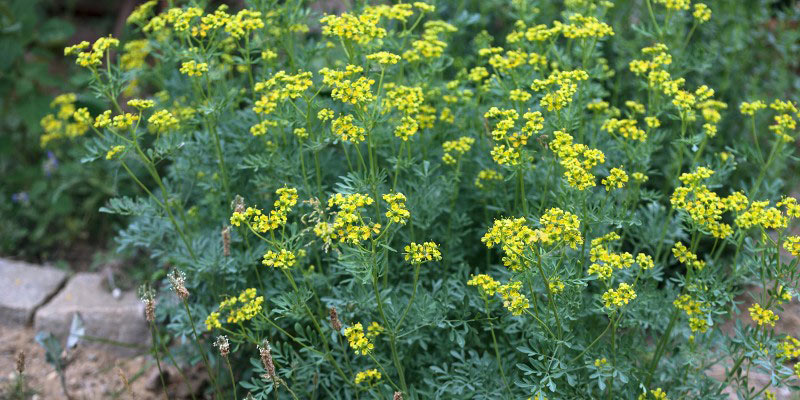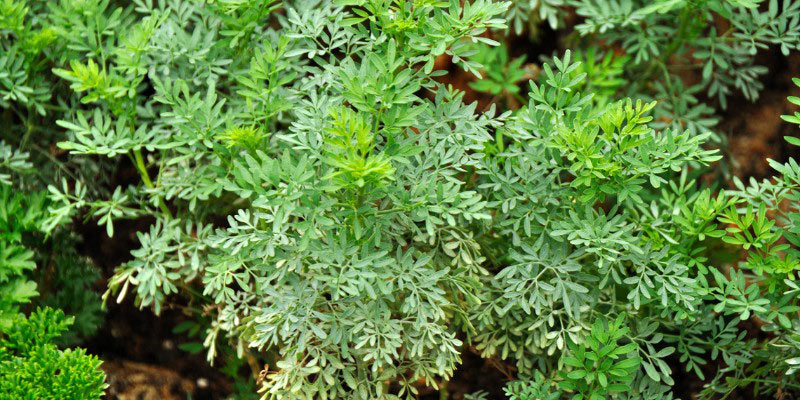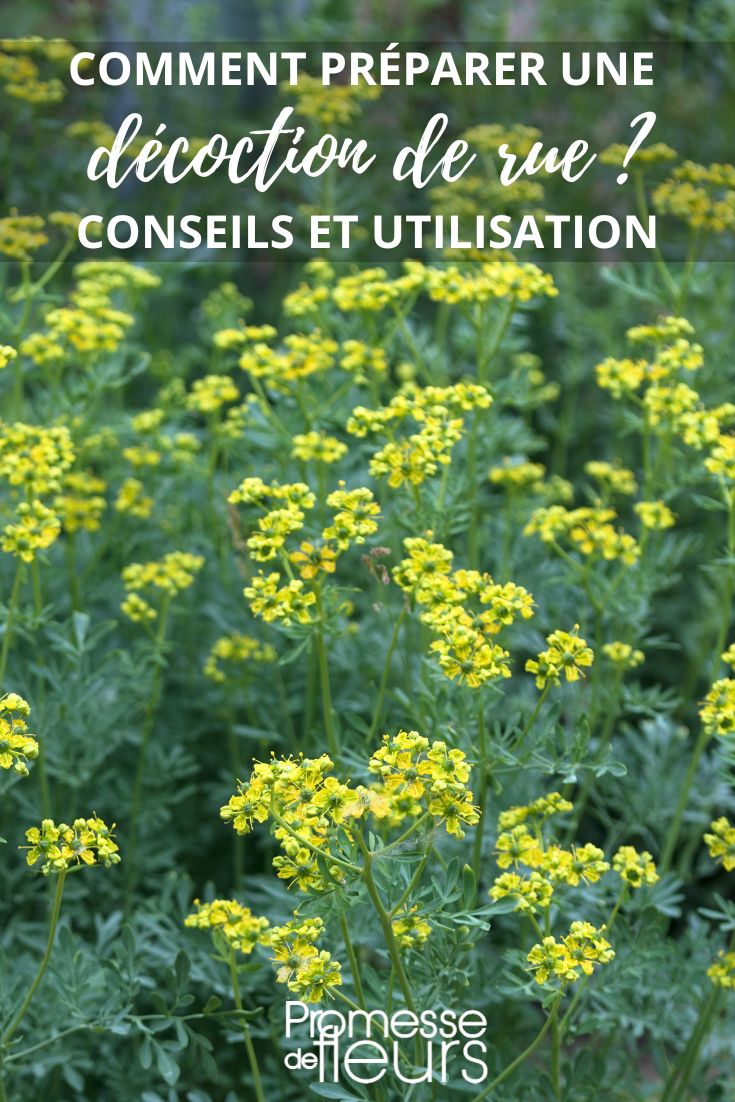Rue officinale, Ruta graveolens, is a perennial aromatic and medicinal plant recognisable by its blue-green foliage and distinctive odour. It has many benefits. Decoction of rue officinale is a natural repellent, with insect-repellent and fungicidal properties very useful in the garden. This preparation, which differs from a manure, helps deter harmful insects and prevent certain fungal diseases thanks to its active compounds. Let’s see how to prepare an effective rue decoction and discover its possible uses on garden plants.

What is rue decoction used for?
Decoction of rue officinale acts as a natural insecticidal and insect-repellent treatment against pests, a repellent to deter domestic animals by its odour, and even a fungicidal agent against cryptogamic diseases in the garden. It is used to:
- Strengthen plants : Active compounds in rue help improve plant resistance to environmental stresses, thereby boosting vigour.
- Protect against pests : Decoction acts as a natural repellent against aphids, ants, flea beetles, flies, moths, thrips, slugs and snails, thus limiting infestations without resorting to chemical products.
- Prevent fungal and bacterial diseases : It works as a fungicidal natural treatment, helping limit onset of cryptogamic diseases such as downy mildew, rust and powdery mildew.
- Repel animals : Dogs, cats, field mice — put off by its strong odour when sprayed around patio edges, pots or beds — are likely to turn away.
- Stimulate plant growth : In addition to protection, certain substances in the decoction can promote healthy, robust growth.
Manure or decoction? What are the differences?
Manure and decoction are two plant extracts used in organic gardening, but their preparation differs. Manure is obtained by fermenting the plant in water for several days, whereas decoction involves boiling the plant in water to extract active principles quickly. This process produces a concentrated solution of beneficial substances within a few hours, without fermentation. Decoction allows faster extraction, providing a ready-to-use solution in no time.
Find out more about the differences between manure and decoction in our advice sheet!
When and how to harvest rue?
Best to harvest rue leaves in late spring (May–June), just before flowering. For best results, harvest early in the morning. At that time of day, essential oils responsible for the plant’s repellent and medicinal properties are at their highest concentration. These volatile compounds, more abundant and potent after the plant’s night-time rest, give greater efficacy to the final decoction.
When selecting leaves to harvest, favour those that are healthy, vigorous and free from any sign of disease or damage. Healthy leaves ensure only desired active principles are extracted and minimise risk of contaminating the decoction with pathogenous or parasitic organisms.
It is essential to wear gloves when handling rue officinale. Plant is toxic on contact. It contains compounds that can cause a phototoxic reaction on skin when exposed to sunlight, and may cause skin irritation (redness, burns, blisters...). This precaution protects skin from possible irritation or allergic reactions.
Using a pruning shear, cut stems just above a leaf node. This encourages plant to produce new shoots from the cut point, promoting bushy, healthy growth.
After harvesting, thorough washing of leaves is essential to remove dust residues, small soil particles and any small insects that may have clung to the leaves.

How to prepare rue decoction?
Decoction is prepared from 100 grams of fresh leaves per 1 litre of water to create a concentrated solution suitable for various applications.
- Chop rue leaves.
- In a suitably sized saucepan, place rue leaves, then cover with water.
- Slowly bring the mixture to the boil. Once water starts boiling, reduce heat to maintain a gentle simmer.
- Let the mixture simmer gently for about 20 minutes. Partially cover the pan to limit evaporation while allowing steam to escape.
- Then remove pan from heat and let mixture cool to room temperature for several hours, or overnight.
- Strain the decoction.
- Transfer strained decoction into clean bottles or jerrycans.
- please note : Decoction generally keeps for about one week in the refrigerator.
How to use it?
Rue decoction is mainly used to naturally repel pests and protect garden plants.
Preparing the solution
Rue decoction is not usually applied undiluted to plants. Use diluted in rainwater if possible before spraying onto vegetation, at a rate of 1 litre decoction to 10 litres water in a watering can. It may be used undiluted provided it does not come into direct contact with plant foliage, for example when sprayed at plant base. Prefer to apply early morning or late afternoon to reduce risk of leaf scorch, and obviously when no rain is forecast.
Application to foliage
Careful application to foliage helps deter insects and prevent foliar diseases by forming a protective barrier. For an even application, use a clean sprayer and distribute the decoction over entire foliage, including inner leaf surfaces, where many pests like to shelter. An application every 15 to 20 days is generally recommended.
Application at plant base
Applying rue decoction directly to soil around plant base strengthens overall plant health and resistance. This allows roots to absorb active principles directly, thus promoting a stronger immune response. As with foliar application, prefer early morning: this allows solution to penetrate soil without rapid evaporation, providing prolonged contact with roots. An application every 4 to 6 weeks during growing season is generally recommended.
Important : Monitor plant reaction carefully after first applications. Improvement in vigour, growth and resistance to stress and disease indicates decoction is beneficial. Adjust concentration or frequency of application if necessary. Although natural, plant decoctions remain active products. Avoid excessive use so as not to disturb the natural balance of garden and vegetable patch.

Equipment
- pruning shear for harvesting rue
- Clean, sharp knife
- Saucepan
- Strainer to filter mixture
- Funnel
- Plastic jerrycan
- Rainwater
- Sprayer
































Comments